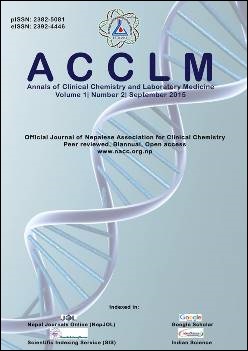Seroprevalence and Related Risk Factors of HBsAg, Anti–HCV and Anti–HIV Antibody Among Pregnant Women of Rural India
DOI:
https://doi.org/10.3126/acclm.v1i2.12956Keywords:
Hepatitis B Virus (HBV), Hepatitis C Virus (HCV), Human immuno deficiency virus (HIV), Pregnant women, Janani sureksha yojana (JSY)Abstract
BACKGROUND: Vertical transmission is also mode of transmission of HBV, HCV and HIV. Viral infections may cause abortion, ectopic pregnancies and HBV, HCV also causes hepatitis, cirrhosis. ‘Janani Sureksha Yojana’ (safe motherhood program) is a scheme in which pregnant women are benefited if they deliver in government medical facility. Antenatal screening for HBV, HCV and HIV should be done so as to provide appropriate antiviral therapy. The aim of study was to detect the frequency of HBsAg, HCV antibody, HIV antibody and their correlation with risk factors.
METHODS: Present study was conducted in central laboratory of Rural Institute of Medical Science and Research Saifai, Etawah (Uttar Pradesh) on pregnant women from 1 January to 31 December 2014.
RESULTS: Out of 7867 women, 2.07% were positive for HBsAg, 0.43% and 0.13% for HCV antibody and HIV antibody, respectively. The age group with maximum seropositivity was in 21-30 year (76.44%) and parity with maximum seropositivity was 3-4 children (42.30%). Seropositivity was high among low socio economic status (77.40%). Among the associated risk factors Obstetric and Gynaecology surgeries (46.15%) and blood transfusion (20%) were prominent. These associated risk factors were found more among HBsAg seropositive females (86.66%) and (84.61%) respectively.
CONCLUSIONS: The prevalence of HBsAg positive (2.07%) was more. Obstetric and Gynaecology surgery, blood transfusion were major risk factors. So, screening for HBsAg, HCV antibody, HIV antibody should be mandatory for pregnant women to reduce mortality and morbidity.
Downloads
Downloads
Published
How to Cite
Issue
Section
License
Authors who publish with this journal agree to the following terms:
- The author transfers copyright to the Nepalese Association for Clinical Chemistry.
- The journal publishes the work under a Creative Commons Attribution License that allows others to share the work with an acknowledgement of the work's authorship and initial publication in this journal and under the same share-alike license used here.
- Authors are able to enter into separate, additional contractual arrangements for the non-exclusive distribution of the journal's published version of the work (e.g., post it to an institutional repository or publish it in a book), with an acknowledgement of its initial publication in this journal.
- Authors are permitted and encouraged to post their work online (e.g., in institutional repositories or on their website) prior to and during the submission process, as it can lead to productive exchanges, as well as earlier and greater citation of published work (See The Effect of Open Access).




